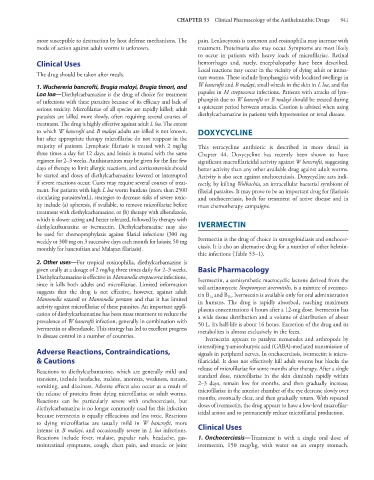Page 955 - Basic _ Clinical Pharmacology ( PDFDrive )
P. 955
CHAPTER 53 Clinical Pharmacology of the Antihelminthic Drugs 941
more susceptible to destruction by host defense mechanisms. The pain. Leukocytosis is common and eosinophilia may increase with
mode of action against adult worms is unknown. treatment. Proteinuria also may occur. Symptoms are most likely
to occur in patients with heavy loads of microfilariae. Retinal
Clinical Uses hemorrhages and, rarely, encephalopathy have been described.
Local reactions may occur in the vicinity of dying adult or imma-
The drug should be taken after meals. ture worms. These include lymphangitis with localized swellings in
1. Wuchereria bancrofti, Brugia malayi, Brugia timori, and W bancrofti and B malayi, small wheals in the skin in L loa, and flat
Loa loa—Diethylcarbamazine is the drug of choice for treatment papules in M streptocerca infections. Patients with attacks of lym-
of infections with these parasites because of its efficacy and lack of phangitis due to W bancrofti or B malayi should be treated during
serious toxicity. Microfilariae of all species are rapidly killed; adult a quiescent period between attacks. Caution is advised when using
parasites are killed more slowly, often requiring several courses of diethylcarbamazine in patients with hypertension or renal disease.
treatment. The drug is highly effective against adult L loa. The extent
to which W bancrofti and B malayi adults are killed is not known, DOXYCYCLINE
but after appropriate therapy microfilariae do not reappear in the
majority of patients. Lymphatic filariasis is treated with 2 mg/kg This tetracycline antibiotic is described in more detail in
three times a day for 12 days, and loiasis is treated with the same Chapter 44. Doxycycline has recently been shown to have
regimen for 2–3 weeks. Antihistamines may be given for the first few significant macrofilaricidal activity against W bancrofti, suggesting
days of therapy to limit allergic reactions, and corticosteroids should better activity than any other available drug against adult worms.
be started and doses of diethylcarbamazine lowered or interrupted Activity is also seen against onchocerciasis. Doxycycline acts indi-
if severe reactions occur. Cures may require several courses of treat- rectly, by killing Wolbachia, an intracellular bacterial symbiont of
ment. For patients with high L loa worm burdens (more than 2500 filarial parasites. It may prove to be an important drug for filariasis
circulating parasites/mL), strategies to decrease risks of severe toxic- and onchocerciasis, both for treatment of active disease and in
ity include (a) apheresis, if available, to remove microfilariae before mass chemotherapy campaigns.
treatment with diethylcarbamazine, or (b) therapy with albendazole,
which is slower acting and better tolerated, followed by therapy with
diethylcarbamazine or ivermectin. Diethylcarbamazine may also IVERMECTIN
be used for chemoprophylaxis against filarial infections (300 mg
weekly or 300 mg on 3 successive days each month for loiasis; 50 mg Ivermectin is the drug of choice in strongyloidiasis and onchocer-
monthly for bancroftian and Malayan filariasis). ciasis. It is also an alternative drug for a number of other helmin-
thic infections (Table 53–1).
2. Other uses—For tropical eosinophilia, diethylcarbamazine is
given orally at a dosage of 2 mg/kg three times daily for 2–3 weeks. Basic Pharmacology
Diethylcarbamazine is effective in Mansonella streptocerca infections, Ivermectin, a semisynthetic macrocyclic lactone derived from the
since it kills both adults and microfilariae. Limited information soil actinomycete Streptomyces avermitilis, is a mixture of avermec-
suggests that the drug is not effective, however, against adult tin B and B . Ivermectin is available only for oral administration
1a
1b
Mansonella ozzardi or Mansonella perstans and that it has limited in humans. The drug is rapidly absorbed, reaching maximum
activity against microfilariae of these parasites. An important appli- plasma concentrations 4 hours after a 12-mg dose. Ivermectin has
cation of diethylcarbamazine has been mass treatment to reduce the a wide tissue distribution and a volume of distribution of about
prevalence of W bancrofti infection, generally in combination with 50 L. Its half-life is about 16 hours. Excretion of the drug and its
ivermectin or albendazole. This strategy has led to excellent progress metabolites is almost exclusively in the feces.
in disease control in a number of countries.
Ivermectin appears to paralyze nematodes and arthropods by
intensifying γ-aminobutyric acid (GABA)-mediated transmission of
Adverse Reactions, Contraindications, signals in peripheral nerves. In onchocerciasis, ivermectin is micro-
& Cautions filaricidal. It does not effectively kill adult worms but blocks the
release of microfilariae for some months after therapy. After a single
Reactions to diethylcarbamazine, which are generally mild and
transient, include headache, malaise, anorexia, weakness, nausea, standard dose, microfilariae in the skin diminish rapidly within
vomiting, and dizziness. Adverse effects also occur as a result of 2–3 days, remain low for months, and then gradually increase;
the release of proteins from dying microfilariae or adult worms. microfilariae in the anterior chamber of the eye decrease slowly over
Reactions can be particularly severe with onchocerciasis, but months, eventually clear, and then gradually return. With repeated
diethylcarbamazine is no longer commonly used for this infection doses of ivermectin, the drug appears to have a low-level macrofilar-
because ivermectin is equally efficacious and less toxic. Reactions icidal action and to permanently reduce microfilarial production.
to dying microfilariae are usually mild in W bancrofti, more Clinical Uses
intense in B malayi, and occasionally severe in L loa infections.
Reactions include fever, malaise, papular rash, headache, gas- 1. Onchocerciasis—Treatment is with a single oral dose of
trointestinal symptoms, cough, chest pain, and muscle or joint ivermectin, 150 mcg/kg, with water on an empty stomach.

